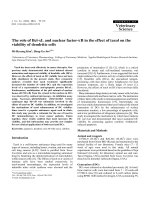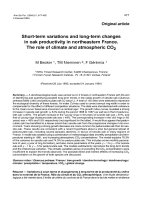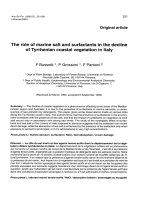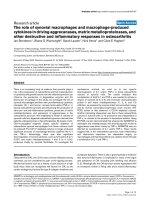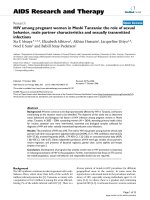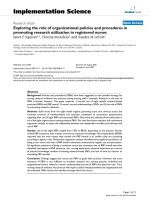How to engage european american participants in racial dialogues the role of dialogue structure and mixed race groups
Bạn đang xem bản rút gọn của tài liệu. Xem và tải ngay bản đầy đủ của tài liệu tại đây (1.44 MB, 115 trang )
Graduate Theses and Dissertations
Iowa State University Capstones, Theses and
Dissertations
2017
How to engage European-American participants in
racial dialogue: The role of dialogue structure and
mixed race groups
Meredith Tittler
Iowa State University
Follow this and additional works at: />Part of the Counseling Psychology Commons, Educational Psychology Commons, International
and Intercultural Communication Commons, and the Race, Ethnicity and Post-Colonial Studies
Commons
Recommended Citation
Tittler, Meredith, "How to engage European-American participants in racial dialogue: The role of dialogue structure and mixed race
groups" (2017). Graduate Theses and Dissertations. 15629.
/>
This Thesis is brought to you for free and open access by the Iowa State University Capstones, Theses and Dissertations at Iowa State University Digital
Repository. It has been accepted for inclusion in Graduate Theses and Dissertations by an authorized administrator of Iowa State University Digital
Repository. For more information, please contact
How to engage European-American participants in racial dialogues: The role of dialogue
structure and mixed race groups
by
Meredith Tittler
A thesis submitted to the graduate faculty
in partial fulfillment of the requirements for the degree of
MASTER OF SCIENCE
Major: Psychology (Counseling)
Program of Study Committee:
Nathaniel Wade, Major Professor
Loreto Prieto
Katy Swalwell
Iowa State University
Ames, Iowa
2017
Copyright © Meredith Tittler, 2017. All rights reserved.
ii
TABLE OF CONTENTS
Page
ABSTRACT………………………………. ..............................................................
iv
CHAPTER 1
INTRODUCTION: OVERVIEW ...................................................
1
CHAPTER 2
LITERATURE REVIEW ...............................................................
9
Dialogues on Race ...............................................................................................
Dialogue Participants ...........................................................................................
Future Research ...................................................................................................
Current Study ......................................................................................................
Hypotheses .........................................................................................................
10
17
34
39
41
CHAPTER 3 METHODS .....................................................................................
Pilot Testing ........................................................................................................
Participants .........................................................................................................
Measures .........................................................................................................
Internal and External Motivations to Respond
Without Prejudice (IMS/EMS) ......................................................................
Colorblind Racial Attitudes Scale (CoBRAS) ...............................................
Positive Previous Experience with African Americans .................................
Crowne & Marlow Social Desirability Scale – Short Form ..........................
Demographic items ........................................................................................
Vignette response items .................................................................................
Vignette outcome items .................................................................................
Procedures .........................................................................................................
Vignette conditions ........................................................................................
44
44
47
48
CHAPTER 4 RESULTS .......................................................................................
Preliminary Analyses ...........................................................................................
Primary Analyses ................................................................................................
55
55
61
CHAPTER 5 DISCUSSION ................................................................................
Limitations .........................................................................................................
Future Directions .................................................................................................
Conclusion .........................................................................................................
70
79
81
83
REFERENCES ..........................................................................................................
84
48
49
50
51
51
52
53
53
54
iii
APPENDIX A.
INTERNAL/EXTERNAL MOTIVATION
TO RESPOND WITHOUT PREJUDICE
SCALES (IMS/EMS)........................................................................................
POSITIVE PREVIOUS EXPERIENCE WITH
AFRICAN AMERICANS ................................................................................
COLOR BLIND RACIAL ATTITUDES SCALE (COBRAS) ......................
MARLOW-CROWNE SOCIAL DESIRABILITY
SCALE – SHORT FORM ...............................................................................
DEMOGRAPHIC ITEMS ................................................................................
CONVERSATION INTRO AND OUTCOME ITEMS
(BLACK LIVES MATTER).............................................................................
CONVERSATION INTRO AND OUTCOME ITEMS
(MINORITY ONLY CONVERSATION) .......................................................
OTHER OUTCOME VARIABLES ................................................................
VIGNETTES.....................................................................................................
APPENDIX B.
IRB APPROVAL ..............................................................................................
90
92
93
94
95
96
100
104
105
109
iv
ABSTRACT
One effective strategy for combatting racism and promoting understanding across racial
lines is group dialogue (e.g., Nagda, 2006). Previous research of racial dialogues has used a selfselecting participant pool of individuals who are motivated to participate in racial dialogues (e.g.,
Gurin, Nagda & Zuniga, 2013). Research up to this point has not investigated the portion of the
population who do not willingly participate in racial dialogues. Previous research suggests that
European-Americans may be a portion of the population especially avoidant of racial dialogues
(e.g., Sue, 2013). Understanding the reasons European-Americans are avoidant of racial
dialogues is an important prerequisite to creating interventions to increase participation. In the
current study, I examined factors that affect European-American participants’ interest and
willingness to participate in a racial dialogue. The specific factors are: facilitator structuring of
the dialogue with ground rules (structured condition) vs. a facilitator who does no structuring
beyond introducing the conversation topic (not-structured condition), as well as the effect of
being in an inter-group dialogue (mixed race group) vs. an intra-group dialogue (all-EuropeanAmerican group). Participants were randomly assigned to one of four conditions of a racial
dialogue vignette varying across the two variables (structured vs. not-structured; inter-group vs.
intra-group).
The main findings from this study include a significant interaction between the racial
make-up of the dialogue group and the structure of the group on participants’ willingness to
share their honest thoughts. It was found that participants were more willing to share their
thoughts in structured, mixed-race groups than structured all- European-American groups or not-
v
structured mixed-race groups. I also found that the structure of the group had a significant effect
on participants’ reported interest in participating in a similar group on campus.
1
CHAPTER 1. INTRODUCTION
Almost 20 years ago, President Clinton issued an Executive Order to create a Race
Advisory Board for the “purpose of examining race, racism, and potential racial reconciliation in
America” (Bingham, Porche-Burke, James, Sue & Vasquez, 2002, p. 76). In the published
report, the President’s Initiative on Race (PIoR, 1998) it was concluded that “racism is far from
being eradicated in American society and that most citizens of this nation seem ill-equipped to
deal with their own personal biases and prejudices” (Bingham et al., 2002, p. 76). A quick look
at local and national media reports would suggest that not much has changed in this regard.
However, one effort to address racism that has garnered political, community, and empirical
support is open dialogues about diversity (Dessel, Rogge & Garlington, 2006). Understanding
the degree to which European-American majority people are willing to engage in these open
dialogues and the personal and contextual factors that affect that willingness is an important next
step for applied research in this area. Such information could provide a foundation for more
empirically-supported methods of reaching both minority and majority people and helping them
come together for effective race dialogues.
Overview of the Problem
Racism and racial inequality remains prevalent and pervasive throughout U.S. society.
One of the highest profile movements currently addressing racial injustice, “Black Lives Matter,”
laments the racial inequality with regard to policing. The movement was begun as an outlet for
public outrage after the acquittal of a European-American man who shot an unarmed AfricanAmerican boy, Trayvon Martin, in 2012. It has continued to gain traction after several highprofile police shootings of unarmed men of color that have occurred since. In addition to these
publicized shootings, less publicized inequalities play out in different contexts across the
2
country. The numbers in the yearly United States education and incarceration statistics show a
system that is biased along racial lines. African Americans make up only 13% of the US
population but they comprise up to 40% of the inmate population and 34% of all high school
dropouts (Hartney & Vuong, 2009; Brown & Lent, 2008). The numbers in the 2015 National
Assessment of Educational Progress (NAEP) illustrate the unofficial segregation of public
schools that still exists in our country. In 2015, European-American students, on average,
attended schools that were 9 percent African-American, while African-American students
attended schools that were 48 percent African-American (National Assessment of Educational
Progress, 2015). The fact that public schools are still unofficially segregated becomes significant
when one sees the difference in money different school systems spend per student. The Chicago
public school system, whose student population is about 87% African-American and Latino,
spends on average $8,482 annually per student. A nearby suburb, Highland Park, whose student
population is 90% European-American, spends $17,291 annually per student (Kozol, 2005).
This stark difference in resources drawn down racial lines is replicated in the major cities across
the country (Kozol, 2005). With predominantly European-American school districts spending
more than twice as much per student than school districts that are made up of predominantly
African-American and Latino students, the achievement gap between students of color and
European-American students seems like an obvious result.
Although the existence of racism in our current society is contested by many, the
detrimental effects of perceived racism are very real. Research has shown that racial
microaggressions negatively affect both the physical and mental health of recipients and have
also been documented to lower work productivity and cognitive abilities (Sue, Lin, Torino,
Capodilupo & Rivera, 2009). There are negative consequences of microaggressions for
3
European-American people as well, such as lowering empathic ability, diming perceptual
awareness, maintaining false illusions and lessening compassion for others (Sue et al, 2009).
Efforts to address racism and its effects
There are numerous ways that leaders throughout the U.S. have worked to counter racism
and its effects, from national legislative efforts to local initiatives and programs. One of the ways
that racism might be countered at the personal and individual level is through open dialogue
about race. In fact, the report from President Clinton’s Executive Order proposed that one of the
most effective tools for bridging the gap between people of different races is dialogue (PIoR,
1998). As a result, one goal for that year was to “spark an extensive dialogue in which people
throughout America could freely discuss how problems of race have impinged on their lives and
affected the Nation in ways that could impede progress in other areas,” (PIoR, 1998, p. 23).
Dialogue, though not the only tool or avenue to address racial tensions, was noted in the report as
being one of the most effective ways for “finding common ground and developing new
understanding among people of different races” (PIoR, 1998, p. 23).
The report distinguished the difference between dialogue and debate. The main
difference being the objective between the two: “the object of debate is to persuade others to
one’s point of view. The object of dialogue is to exchange ideas and find common ground”
(PIoR, 1998, p. 23). The success of a dialogue can be measured by how “well participants
develop a tolerance for differing perspectives and a shared insight of the issue” (PIoR, p. 24).
Others have sought to further define what these dialogues should look like and what factors
should comprise them.
The Ford Foundation, a private foundation with the stated mission of advancing human
welfare, created the “Difficult Dialogue” initiative in 2005 with the release of 2.5 million dollars
4
in grants to “support scholarship, teaching, and civil dialogue about difficult political, religious,
racial, and cultural issues in undergraduate education in the United States” (“Ford Foundation
Launches,” 2005, para. 1). As a result, Difficult Dialogue initiatives have since sprung up on
campuses throughout the country. These efforts are diverse in the department and disciplinary
faculty who lead them, the content that is addressed as well as the format in which the dialogues
take place (O’Neil, 2006). The call for dialogue has also reached work environments. Diversity
trainings in workplaces were reported to be used by 66% of US employers in 2005 (Paluck,
2006).
An effort to create a structure and format for these dialogues has been pioneered by
different research teams. The “Inter-Group Dialogue” program (IGD) is one such format. The
program is a “co-facilitated, face-to-face, small group intervention that brings individuals
together from social identity groups with a history of tension or conflict” (Miles & Kivlighan,
2012, p. 190). The intergroup contact hypothesis (Allport, 1954) informs much of the practice of
the program with the theory that intergroup contact, under the conditions of equal status and
shared goals, can reduce intergroup prejudice (Miles & Kivlighan, 2012).
The composition of the group ideally includes equal numbers of members from both the
oppressed and the privileged social identity groups and is co-facilitated by a member from each
identity group (Muller, 2015). The groups consist of 8-10 participants and meet for 7-12 weeks
(Muller, 2015). The “four-stage model” of intergroup dialogue outlines four stages that the group
works through during the time that it meets. The four stages are: 1) group beginnings/forming
and building relationships, 2) exploring differences and commonalities of experience, 3)
exploring and dialoging about hot topics, and 4) action planning and alliance building (Muller,
2015).
5
Others have also attempted to define and understand effective racial dialogue. Sue (2013)
defines “race talk” as “any dialogue or conversation about race that touches upon topics of race,
racism, ‘whiteness’, and White privilege” (p. 664). These dialogues (or “talks”) can happen any
time and any place. Sue focuses specifically on times when they occur in university classrooms,
often when microaggressions trigger the discussion (Sue, 2013). The outcome of these
discussions is in no way determined: they can harden the tension across racial lines or soften
racially prejudiced views, if facilitated correctly. Sue et al.’s (2009) qualitative research on the
subject has uncovered several strategies that teachers, or any group leader, can use to facilitate a
more effective dialogue, including: 1) acknowledging emotions and feelings, 2) self-disclosing
personal challenges and fears, 3) actively engaging the classroom exchanges, and 4) creating a
safe space for racial dialogues.
Researchers have begun to evaluate the outcomes of these group interventions, but the
use of dialogue still outpaces the research of such programs (Dessel & Rogge, 2008). In one of
the few effectiveness studies of racial dialogues, Gurin, Nagda and Zuniga (2013) conducted a
nine-university collaborative study to look at the processes and results of race/ethnicity and
gender intergroup dialogue programs. The researchers used an experimental design with a
treatment group comprised of students participating in the IGD programs and a control group
comprised of students assigned to a wait list. The results of the study showed that students in
both the race/ethnicity and gender dialogues had greater increases in awareness and
understanding of racial and gender inequalities and their societal causes than students in the
control group or students in social science classes. Students participating in the dialogues also
showed increased motivation to bridge differences across race and gender lines as well as greater
increases in empathy (Gurin et al., 2013). This is the one known empirical study of the IGD
6
program that used a control group with random assignment. Despite the many strengths of this
study there are still limitations, such as a participant sample pool comprised of motivated, selfselecting students who willingly signed up for dialogues– this means interpreting the results
should be done with caution and should not be generalized to the general population. The use of
dialogues to create proactive discussion about issues of race continues to expand and the research
effort is beginning to address some of the holes in the literature, but there is still a long way to
go.
One thing that educators, politicians and social scientists seem to agree on is the fact that
dialogues are a viable and effective tool for promoting racial understanding and easing tension
across racial lines. The research that is being produced is supporting these claims and showing
that dialogue should remain an important method of addressing racial issues in our country.
Understanding and increasing participation in racial dialogues
If these racial dialogues have been shown to be effective, then the next important
question is, “how do we increase participation in such discussions?” One possibility is for
leaders to be prepared for, and to capitalize, on situations in which diverse individuals are
already together in a group. For example, there are the cases of spontaneous “race talks,” which
are triggered in classrooms and therefore all students within the classroom become de facto
participants or observers without much choice (e.g., Sue, 2013). However, even in these
settings, students have the choice to participate or evade the discussion by remaining silent or
even leaving the room (Sue, 2013). Thus, it is likely that more effective dialogues would occur in
voluntary groups that are designed from the outset as racial dialogues. Of course, one can
imagine that the group of individuals who self-select for these types of discussions are perhaps
qualitatively different than those who do not volunteer. Given Sue’s description of race talks as,
7
“filled with intense and powerful emotions… [and that] the majority of people in interracial
settings would prefer to avoid them and/or to minimize and dilute their importance” (p. 664), one
can imagine that a large portion of the population, if given the choice, would not willingly agree
to be a part of these conversations. Therefore, an important research question to answer is, “how
do we get more people to willingly engage in these discussions?”
The first step in understanding how to get more people involved is to answer the basic
question of whether the assumption is true that most people—and more specifically that most
European-American people—would choose to avoid these discussions. Initial research evidence
suggests that there is a racial difference in people’s willingness to participate in such dialogues.
Several studies have documented the defensive and evasive behavior that is exhibited by
European-American participants in these types of discussions. Sue (2013) listed some of these
behaviors as: remaining silent and refusing to participate in the dialogue, changing the topic,
dismissing the importance of the topic, creating strict rules for how the dialogue should take
place and taking a global, detached perspective when discussing race issues. DiAngelo (2011)
describes similar behaviors in her description of what she calls “White Fragility”, which she
characterizes as defensive behaviors such as arguing, remaining silent or leaving the discussion
when the topic turns to race. She contends that these behaviors are due to the “insulated
environment of racial protection that builds White expectations for racial comfort while at the
same time lowering the ability to tolerate racial stress,” (DiAngelo, 2011, p. 55).
One study illustrated a potential avoidance of race issues through the distance EuropeanAmerican subjects spaced their chairs from their partner’s when they anticipated talking to an
African-American partner about racial profiling. The European-American participants put their
chair significantly closer to their partners’ when the topic was on something besides racial
8
profiling or when their partner was not African-American (Goff, Steele & Davies, 2008).
Another study also found that students of color had a higher level of comfort in communicating
across differences than European-American students (Nagda & Zúñiga, 2003). In the context of
groups, members in a high-power (or privileged) group wanted to discuss power differential less
than the members of the low power group when given the choice of discussion topic in a group
setting (Saguy, Dovidio & Pratto, 2008).
All of the above findings suggest that European-American people, compared to people of
color, will be less likely to willingly engage in racial dialogue. The absence or unwillingness of
majority participants to engage in these conversations is potentially a crucial obstacle to effective
racial dialogues. As a result, knowing the actual degree of willingness, and what predicts that
willingness to participate among European-American people, is an important starting point.
9
CHAPTER 2. LITERATURE REVIEW
More than 60 years have passed since racial segregation in schools was made illegal in
Brown v. Board of Education, yet inequality along racial lines still remains an issue in the USA.
The ‘Black Lives Matter’ movement is the most recent public reaction to a spate of publicized
police shootings of unarmed African-American men. The movement has recently brought these
enduring issues of racial inequality to the surface of public discourse. The yearly statistics for
incarceration show a system that is biased along racial lines; African Americans comprise only
13% of the general US population but up to 40% of the inmate population (Hartney & Vuong,
2009). Statistics in education tell a similar story with achievement being lowest in schools with
the highest percentages of African-American students (National Assessment of Educational
Progress, 2015). African American students have also been reported to make up 34% of all high
school dropouts (Brown & Lent, 2008). The police shootings of unarmed men of color is
perhaps the most jarring and visible symptom of a system-wide issue with race. The subsequent
riots and the media attention they have garnered have pulled the public’s eye to the issue in a
more powerful way than the yearly statistics reports.
The social dynamics at play that have maintained this inequality despite the passing of
Brown v. Board of Education decades ago, are pervasive, subtle and difficult to identify. The
inequality that occurs today looks different than it once did. Racial segregation is now illegal,
being racist is stigmatized and the professed public values have become more egalitarian with
each passing decade (Forman & Lewis, 2015). The inequality that exists today is a much
stealthier creature to treat than it was in the days of overt racism. It is one that has evaded
researchers and educators for years.
10
Dialogues on Race
Almost 20 years ago, President Clinton issued an Executive Order to create a Race
Advisory Board for the “purpose of examining race, racism, and potential racial reconciliation in
America” (Bingham, Porche-Burke, James, Sue & Vasquez, 2002, p.76). The report proposed
that one of the most effective tools for bridging the gap between people of different racial and
ethnic backgrounds is dialogue. The report stated that dialogue could be used in “finding
common ground and developing new understanding among people of different races” (PIoR,
1998, p. 23). Efforts to address President Clinton’s call to dialogue began to spring up around
the country in the ensuing years.
One of the most significant of those efforts was The Ford Foundation’s initiative,
“Difficult Dialogues”, which was begun in 2005. As of this time, the Ford Foundation had
provided 2.5 million dollars in grants to “support scholarship, teaching, and civil dialogue about
difficult political, religious, racial and cultural issues in undergraduate education in the United
States” (“Ford Foundation Launches”, 2005, para. 1). Colleges and universities around the
country were invited to submit proposals for grant money that would fund academic programs
that “engage students in constructive discussion of conflicting viewpoints,” (“Ford Foundation
Launches,” 2005, para. 2).
Planned difficult dialogues
One format for planned group dialogues that has been promoted and used by various
community groups and educational institutions over the past two decades is the “Inter-Group
Dialogue” (IGD) program (Dessel, Rogge & Garlington, 2006). The IGD program provides a
framework for difficult dialogues to take place (Miles & Kivlighan, 2012). Dessel, Woodford
and Warren (2011) explain that, “IGD brings together people from two different social-identity
11
groups that have a history of conflict,” (p. 1133). In the IGD format the group is ideally
comprised of equal numbers of participants from the target, or repressed social group, and the
agent, or privileged social group. The group is led by two trained facilitators, one from each of
the represented social-identity groups. IGD has been used with different social identity groups
involving race and ethnic identities (race in the USA, Israeli-Palestinian relations), sexual
orientation (Ahmad, Dessel, Mishkin, Ali & Omar, 2015; Dessel, 2010; Dessel, Woodford, &
Warren, 2011) and with populations as diverse as adolescents (Aldana, Rowley, Checkoway, &
Richards-Schuster, 2012), college students and community groups (Dessel, Rogge, &
Garlington). The IGD program outlines four stages that the group works through with weekly
meetings taking place over a 7-12 week span. The four stages include: 1) group
beginnings/forming and building relationships, 2) exploring differences and commonalities of
experience, 3) exploring and dialoguing about hot topics, and 4) action planning and alliance
building (Muller, 2015).
Initial research into the effectiveness of the IGD format has shown positive results. One
collaborative study, titled the Multi-University Intergroup Dialogue Research Project (MIGR),
included nine universities conducting gender and race/ethnicity dialogue groups. The study
showed that students in these groups (N = 1463) had greater increase in awareness and
understanding across its three outcome variables – intergroup understanding, intergroup
relationships, and intergroup collaboration and action - compared to students assigned to a waitlist and comparison group condition (Gurin, Nagda & Zuniga, 2013). Students also showed
increased motivation to bridge differences across race and gender lines as well as greater
increases in empathy and sense of responsibility (Gurin, Nagda & Zuniga). The results showed
small to moderate effect sizes ranging from .19 to .41 (Cohen’s d) across the three outcome
12
variables. Across all the items for intergroup understanding, effect sizes were an average of .19
at the posttest, but were as high as .25 for items that measured students’ understanding of
structural inequalities along racial lines. The average effect size for intergroup relationships was
.41 and .24 for intergroup action.
Compared to the other research that has been done on IGD groups, this study stands out
for its experimental design and large sample size. The study had two comparison groups: a waitlist group and a comparison group of students enrolled in social studies classes on race/ethnicity
and gender. The comparison group allowed the researchers to control for the effects of receiving
didactic instruction on issues of social inequality compared to the experiential dialogue approach
of the IGD program (Gurin et al. 2013). The study sample was comprised of students who
signed up to be in an IGD group. Students who signed up for the IGD program were then
randomly assigned to a control group or an IGD group. The programs across the nine
universities were designed to be as similar as possible and used similar recruiting and selection
processes as well as stratified random assignment procedures to control for issues with external
validity (Alimo, 2012). The data were collected through pre and post-test surveys, a one year
follow-up survey, and qualitative interviews.
This study, though strong on many factors, does still have limitations. One major
limitation of the MIGR study is the use of a participant pool of self-selecting individuals who
willingly signed up for difficult dialogues on race. Thus, the results of the study cannot be
generalized to the general public and do not show what the effects of IGD may be for individuals
who are not explicitly motivated to participate in a racial dialogue. Random assignment was also
not used for the individuals in the comparison groups of social science classes that addressed
gender or racial content. Another limitation of the study is the lack of control in testing what
13
specific parts of the intervention were most effective in producing change. The IGD program
involved a full curriculum with four stages, structured activities and several readings. There is
no way of knowing what aspects of the curriculum produced which results (Gurin et al., 2013).
Dessel and Rogge (2008) conducted a literature review of IGD studies that spanned a
time period from 1997-2006 and identified a total of twenty-three studies that fell within this
window. All of the studies, with the exception of the MIGR project described above, used either
a quasi-experimental or pre-experimental design, which means that at the very best a nonequivalent control or comparison group was used and none used random assignment. Most of
the studies also had small sample sizes and lacked experimental control (Dessel & Rogge). Thus
the practice of IGD for addressing group conflict shows promise, but there are still holes in the
literature that need to be addressed before any strong conclusions can be drawn.
Spontaneous difficult dialogues
Although planned programs to encourage effective inter-group dialogue are worthwhile
and important, most of the conversations that people have about race are done informally.
Researchers have also explored the informal racial dialogue, or race talk, that is often triggered
in university classrooms. Sue (2013) defines “race talk” as any dialogue or conversation “about
race that touches upon topics of race, racism, “whiteness”, and White privilege” (p. 664). He
and his colleagues have conducted several qualitative studies that have helped define the nature
of these dialogues (e.g., Sue, Torino, Capodilupo, Rivera & Lin, 2009; Sue, Rivera, Capodilupo,
Lin, & Torino, 2010; Sue, Lin, Torino, Capodilupo & Rivera, 2009).
These race talks are most often triggered by microaggressions that European-American
students commit unwittingly during a classroom discussion (Sue, Lin et al., 2009). The most
common themes that were identified by students of color were statements that implied that
14
people of color lack intelligence, don’t belong in this county, are assumed criminals or that race
is not actually an issue in the USA (Sue, Lin et al., 2009). Minority students’ reactions to these
microaggressions varied from wondering whether it was worth it to speak up to having an
emotional reaction that included feeling “incensed,” anxious and exhausted (Sue, Lin et al.,
2009). Different themes also emerged for European-American students’ experiences in difficult
dialogues. Unlike the students of color, who could easily identify specific instances of classroom
discussions on race or microaggressions, the European-American counseling trainees who were
interviewed did not attach their thoughts or experience of race to a specific instance. The
European-American participants, rather, spoke in global terms about their experiences (Sue et al.,
2010). Some of these global themes included denying one’s whiteness or white privilege,
claiming to not see or notice race (otherwise referred to as colorblindness), a fear of appearing
racist if one engaged in a discussion on race, and claiming that one had no right to dialogue
about race because one had never experienced racism themselves (Sue et al., 2010).
In a third study looking at the perspective of European-American faculty members in
difficult dialogues on race, a different set of themes emerged (Sue, Torino et al. 2009). There
were two major themes that faculty cited in what made the dialogues difficult: a fear of losing
control and a rise of the emotional charge in the classroom climate when the topic of race was
breached. Faculty perceived students to react to these conversations with anxiety, anger and
defensiveness. Observed student behaviors included European-American students crying,
European-American students leaving the classroom, and students acting withdrawn with a lack
of verbal participation, blank looks and passive dialogue (Sue, Torino et al., 2009). Professors
themselves reported feeling anxiety, disappointment in themselves and uncertainty in how to
proceed when faced with a difficult dialogue. Faculty also commented on strategies that they



